by Bryan Perry
April 4, 2023
A number of reasons are being touted for the market’s quarter-ending rebound last week, the primary one being the release of the personal consumption index (PCE) that came in fractionally lower than forecast. Reflecting prices in February, PCE inflation ran at an annual pace of 5.0% versus 5.3% in January. The lower reading shows that inflation was moving in the right direction as February ended, five weeks ago.
Although inflation grabs the headlines, I would argue that the main reason the market pivoted higher last week was action by the Bank Term Funding Program (BTFP), an emergency lending program created by the Federal Reserve in mid-March 2023 to provide emergency liquidity to U.S. depository institutions.
The Fed launched this program in a “by the way” announcement that reportedly pushed its balance sheet up by $500 billion. In the past three weeks, the Fed has done a 180-degree reversal, from shrinking its balance sheet through QT and instead injecting massive liquidity into the system. JPMorgan put out a note called “Flows & Liquidity – A Repeat of 2018/2019?” believing that Federal Reserve’s BTFP aid is likely to be massive, projecting that its max usage could be around $2 trillion. (Source: SWFInstitute 03/16/2023).
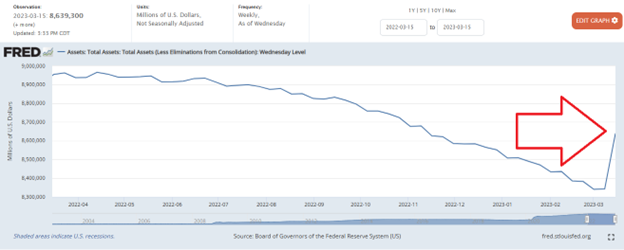
Graphs are for illustrative and discussion purposes only. Please read important disclosures at the end of this commentary.
The Federal Reserve (in Section 13(3)) has the singular power to permit Federal reserve banks to provide liquidity directly to non-bank commercial entities. The JPMorgan research team analyzed the uninsured deposits of the six U.S. banks with the highest ratio of uninsured deposits over total deposits. That number came out to be $460 billion. The more the usage of the BFTP, essentially that would increase the size of the Federal Reserve, thus creating more liquidity relief for the whole U.S. banking system.
This power is only available in times of crisis, when the Federal Reserve, by a vote of five governors, finds that “exigent and unusual circumstances” exist. Section 13(3) authority has been invoked only in unusual times of crisis, like the global financial crisis of 2008 and during the COVID-19 pandemic.
The BFTP program was set up to protect against future runs on deposits, but what about the looming problem with commercial office space debt held by banks? It is estimated there is about $5.5 trillion in commercial real estate debt, of which roughly $2 trillion is committed to multi-family housing projects, considered relatively safe, and around $3.5 trillion in all other sub-classes of commercial real estate, where banks have almost half the exposure, most of which (about 70%) is held by small banks.
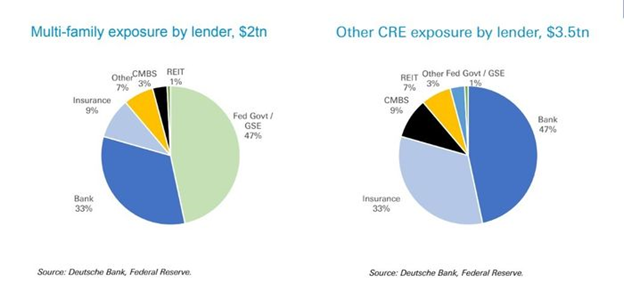
Graphs are for illustrative and discussion purposes only. Please read important disclosures at the end of this commentary.
This situation very likely explains why the Russell 2000 is underperforming most other major indexes. Financial companies account for 15.7% of that index, most of which is represented by small banks. Healthcare is weighted at 15.7%, industrials account for 15.5%, and technology weighting sits at 14.1%.
The chart of the Russell 2000 ETF (IWM) shows a big break in the index, slicing below its key 200-day moving average on huge volume, which, in my view, will take time to repair.
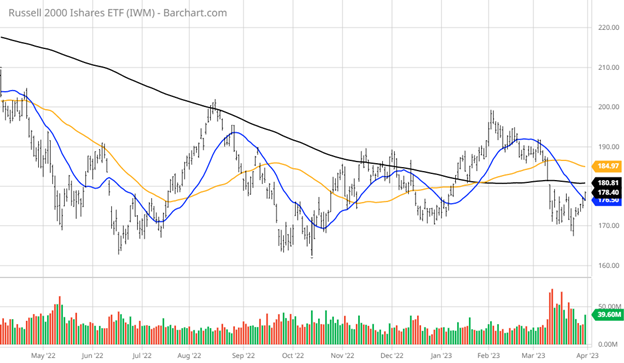
Graphs are for illustrative and discussion purposes only. Please read important disclosures at the end of this commentary.
Working at home took a toll on office usage. The latest Kastle Systems’ gauging of office vacancy in its 10-city barometer was at 48.4% as of March 22 – not a healthy development for the sector.
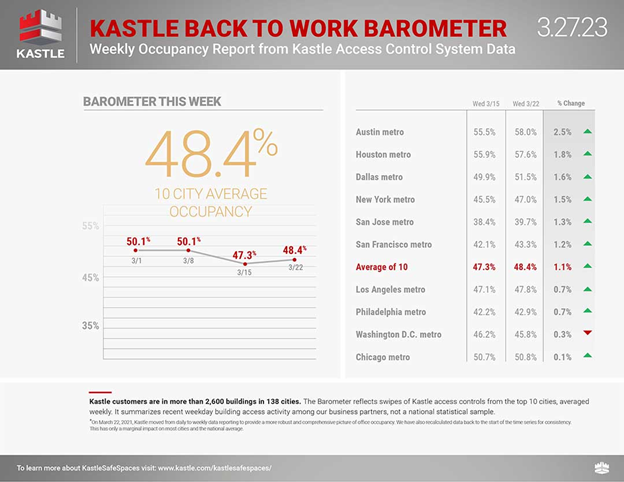
Graphs are for illustrative and discussion purposes only. Please read important disclosures at the end of this commentary.
The concern with the hybrid work environment today is that this sub-50% office occupancy rate is the new norm, which is highly likely to drag down property prices, which brings rising pressure on landlords with billions in debt coming due in the next few years, likely at higher rates. While some borrowers will get loan extensions or modifications, a more expensive funding regime could force others to “hand back the keys,” said BofA Global’s Alan Todd, who leads the bank’s CMBS research effort, in a client note.
To help gauge borrower costs, the average coupon for office loans in multi-borrower, or “conduit,” commercial mortgage bond deals has almost doubled to 6.3% since 2021.
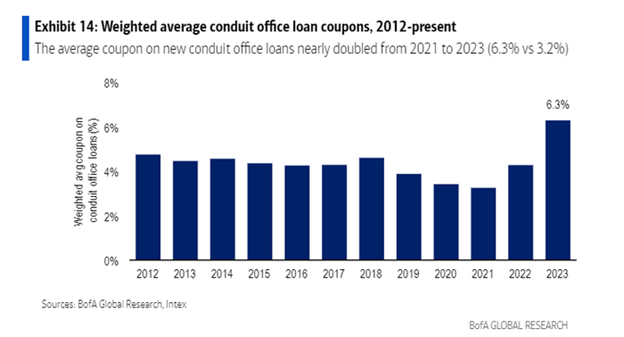
Graphs are for illustrative and discussion purposes only. Please read important disclosures at the end of this commentary.
At the median U.S. bank, commercial real-estate loans account for 38% of loan holdings, according to an analysis by KBW Research. The Federal Reserve recently said it would accept bonds and other assets at face value as collateral from banks, making bank runs less likely. Still, small and regional banks could run into trouble quickly if they have to sell commercial property loans to raise capital, said Richard Jones, a partner with the law firm Dechert LLP. In such a situation, banks would likely be required to reclassify loans as being held for sale. That means valuing them at their current worth rather than their loan value.
While the commercial office space loan risk is high on the list of inherent risks to banks’ balance sheets, the market sees it as something to think about months from now. At the present, and over the very near term, markets seem to only care about the huge injection of money and the view that the Fed, through the BFTP, has indeed pivoted, pausing on QT, flooding the system with fresh dollars to fix the problem they created. And stocks rallied big time on the news. Oh, how markets do love these liquidity injections.
All content above represents the opinion of Bryan Perry of Navellier & Associates, Inc.
Also In This Issue
A Look Ahead by Louis Navellier
The “Wall of Worry” is Crumbling, Brick by Brick
Income Mail by Bryan Perry
The Stock Market Loves Liquidity Injections
Growth Mail by Gary Alexander
The NASDAQ 100 Rose 20% in Q1: Danger or Opportunity
Global Mail by Ivan Martchev
Temporary Good News on the Banking Front
Sector Spotlight by Jason Bodner
Are We on The Edge of a Market Precipice?
View Full Archive
Read Past Issues Here

Bryan Perry
SENIOR DIRECTOR
Bryan Perry is a Senior Director with Navellier Private Client Group, advising and facilitating high net worth investors in the pursuit of their financial goals.
Bryan’s financial services career spanning the past three decades includes over 20 years of wealth management experience with Wall Street firms that include Bear Stearns, Lehman Brothers and Paine Webber, working with both retail and institutional clients. Bryan earned a B.A. in Political Science from Virginia Polytechnic Institute & State University and currently holds a Series 65 license. All content of “Income Mail” represents the opinion of Bryan Perry
Important Disclosures:
Although information in these reports has been obtained from and is based upon sources that Navellier believes to be reliable, Navellier does not guarantee its accuracy and it may be incomplete or condensed. All opinions and estimates constitute Navellier’s judgment as of the date the report was created and are subject to change without notice. These reports are for informational purposes only and are not a solicitation for the purchase or sale of a security. Any decision to purchase securities mentioned in these reports must take into account existing public information on such securities or any registered prospectus.To the extent permitted by law, neither Navellier & Associates, Inc., nor any of its affiliates, agents, or service providers assumes any liability or responsibility nor owes any duty of care for any consequences of any person acting or refraining to act in reliance on the information contained in this communication or for any decision based on it.
Past performance is no indication of future results. Investment in securities involves significant risk and has the potential for partial or complete loss of funds invested. It should not be assumed that any securities recommendations made by Navellier. in the future will be profitable or equal the performance of securities made in this report. Dividend payments are not guaranteed. The amount of a dividend payment, if any, can vary over time and issuers may reduce dividends paid on securities in the event of a recession or adverse event affecting a specific industry or issuer.
None of the stock information, data, and company information presented herein constitutes a recommendation by Navellier or a solicitation to buy or sell any securities. Any specific securities identified and described do not represent all of the securities purchased, sold, or recommended for advisory clients. The holdings identified do not represent all of the securities purchased, sold, or recommended for advisory clients and the reader should not assume that investments in the securities identified and discussed were or will be profitable.
Information presented is general information that does not take into account your individual circumstances, financial situation, or needs, nor does it present a personalized recommendation to you. Individual stocks presented may not be suitable for every investor. Investment in securities involves significant risk and has the potential for partial or complete loss of funds invested. Investment in fixed income securities has the potential for the investment return and principal value of an investment to fluctuate so that an investor’s holdings, when redeemed, may be worth less than their original cost.
One cannot invest directly in an index. Index is unmanaged and index performance does not reflect deduction of fees, expenses, or taxes. Presentation of Index data does not reflect a belief by Navellier that any stock index constitutes an investment alternative to any Navellier equity strategy or is necessarily comparable to such strategies. Among the most important differences between the Indices and Navellier strategies are that the Navellier equity strategies may (1) incur material management fees, (2) concentrate its investments in relatively few stocks, industries, or sectors, (3) have significantly greater trading activity and related costs, and (4) be significantly more or less volatile than the Indices.
ETF Risk: We may invest in exchange traded funds (“ETFs”) and some of our investment strategies are generally fully invested in ETFs. Like traditional mutual funds, ETFs charge asset-based fees, but they generally do not charge initial sales charges or redemption fees and investors typically pay only customary brokerage fees to buy and sell ETF shares. The fees and costs charged by ETFs held in client accounts will not be deducted from the compensation the client pays Navellier. ETF prices can fluctuate up or down, and a client account could lose money investing in an ETF if the prices of the securities owned by the ETF go down. ETFs are subject to additional risks:
- ETF shares may trade above or below their net asset value;
- An active trading market for an ETF’s shares may not develop or be maintained;
- The value of an ETF may be more volatile than the underlying portfolio of securities the ETF is designed to track;
- The cost of owning shares of the ETF may exceed those a client would incur by directly investing in the underlying securities; and
- Trading of an ETF’s shares may be halted if the listing exchange’s officials deem it appropriate, the shares are delisted from the exchange, or the activation of market-wide “circuit breakers” (which are tied to large decreases in stock prices) halts stock trading generally.
Grader Disclosures: Investment in equity strategies involves substantial risk and has the potential for partial or complete loss of funds invested. The sample portfolio and any accompanying charts are for informational purposes only and are not to be construed as a solicitation to buy or sell any financial instrument and should not be relied upon as the sole factor in an investment making decision. As a matter of normal and important disclosures to you, as a potential investor, please consider the following: The performance presented is not based on any actual securities trading, portfolio, or accounts, and the reported performance of the A, B, C, D, and F portfolios (collectively the “model portfolios”) should be considered mere “paper” or pro forma performance results based on Navellier’s research.
Investors evaluating any of Navellier & Associates, Inc.’s, (or its affiliates’) Investment Products must not use any information presented here, including the performance figures of the model portfolios, in their evaluation of any Navellier Investment Products. Navellier Investment Products include the firm’s mutual funds and managed accounts. The model portfolios, charts, and other information presented do not represent actual funded trades and are not actual funded portfolios. There are material differences between Navellier Investment Products’ portfolios and the model portfolios, research, and performance figures presented here. The model portfolios and the research results (1) may contain stocks or ETFs that are illiquid and difficult to trade; (2) may contain stock or ETF holdings materially different from actual funded Navellier Investment Product portfolios; (3) include the reinvestment of all dividends and other earnings, estimated trading costs, commissions, or management fees; and, (4) may not reflect prices obtained in an actual funded Navellier Investment Product portfolio. For these and other reasons, the reported performances of model portfolios do not reflect the performance results of Navellier’s actually funded and traded Investment Products. In most cases, Navellier’s Investment Products have materially lower performance results than the performances of the model portfolios presented.
This report contains statements that are, or may be considered to be, forward-looking statements. All statements that are not historical facts, including statements about our beliefs or expectations, are “forward-looking statements” within the meaning of The U.S. Private Securities Litigation Reform Act of 1995. These statements may be identified by such forward-looking terminology as “expect,” “estimate,” “plan,” “intend,” “believe,” “anticipate,” “may,” “will,” “should,” “could,” “continue,” “project,” or similar statements or variations of such terms. Our forward-looking statements are based on a series of expectations, assumptions, and projections, are not guarantees of future results or performance, and involve substantial risks and uncertainty as described in Form ADV Part 2A of our filing with the Securities and Exchange Commission (SEC), which is available at www.adviserinfo.sec.gov or by requesting a copy by emailing info@navellier.com. All of our forward-looking statements are as of the date of this report only. We can give no assurance that such expectations or forward-looking statements will prove to be correct. Actual results may differ materially. You are urged to carefully consider all such factors.
FEDERAL TAX ADVICE DISCLAIMER: As required by U.S. Treasury Regulations, you are informed that, to the extent this presentation includes any federal tax advice, the presentation is not written by Navellier to be used, and cannot be used, for the purpose of avoiding federal tax penalties. Navellier does not advise on any income tax requirements or issues. Use of any information presented by Navellier is for general information only and does not represent tax advice either express or implied. You are encouraged to seek professional tax advice for income tax questions and assistance.
IMPORTANT NEWSLETTER DISCLOSURE:The hypothetical performance results for investment newsletters that are authored or edited by Louis Navellier, including Louis Navellier’s Growth Investor, Louis Navellier’s Breakthrough Stocks, Louis Navellier’s Accelerated Profits, and Louis Navellier’s Platinum Club, are not based on any actual securities trading, portfolio, or accounts, and the newsletters’ reported hypothetical performances should be considered mere “paper” or proforma hypothetical performance results and are not actual performance of real world trades. Navellier & Associates, Inc. does not have any relation to or affiliation with the owner of these newsletters. There are material differences between Navellier Investment Products’ portfolios and the InvestorPlace Media, LLC newsletter portfolios authored by Louis Navellier. The InvestorPlace Media, LLC newsletters contain hypothetical performance that do not include transaction costs, advisory fees, or other fees a client might incur if actual investments and trades were being made by an investor. As a result, newsletter performance should not be used to evaluate Navellier Investment services which are separate and different from the newsletters. The owner of the newsletters is InvestorPlace Media, LLC and any questions concerning the newsletters, including any newsletter advertising or hypothetical Newsletter performance claims, (which are calculated solely by Investor Place Media and not Navellier) should be referred to InvestorPlace Media, LLC at (800) 718-8289.
Please note that Navellier & Associates and the Navellier Private Client Group are managed completely independent of the newsletters owned and published by InvestorPlace Media, LLC and written and edited by Louis Navellier, and investment performance of the newsletters should in no way be considered indicative of potential future investment performance for any Navellier & Associates separately managed account portfolio. Potential investors should consult with their financial advisor before investing in any Navellier Investment Product.
Navellier claims compliance with Global Investment Performance Standards (GIPS). To receive a complete list and descriptions of Navellier’s composites and/or a presentation that adheres to the GIPS standards, please contact Navellier or click here. It should not be assumed that any securities recommendations made by Navellier & Associates, Inc. in the future will be profitable or equal the performance of securities made in this report.
FactSet Disclosure: Navellier does not independently calculate the statistical information included in the attached report. The calculation and the information are provided by FactSet, a company not related to Navellier. Although information contained in the report has been obtained from FactSet and is based on sources Navellier believes to be reliable, Navellier does not guarantee its accuracy, and it may be incomplete or condensed. The report and the related FactSet sourced information are provided on an “as is” basis. The user assumes the entire risk of any use made of this information. Investors should consider the report as only a single factor in making their investment decision. The report is for informational purposes only and is not intended as an offer or solicitation for the purchase or sale of a security. FactSet sourced information is the exclusive property of FactSet. Without prior written permission of FactSet, this information may not be reproduced, disseminated or used to create any financial products. All indices are unmanaged and performance of the indices include reinvestment of dividends and interest income, unless otherwise noted, are not illustrative of any particular investment and an investment cannot be made in any index. Past performance is no guarantee of future results.
